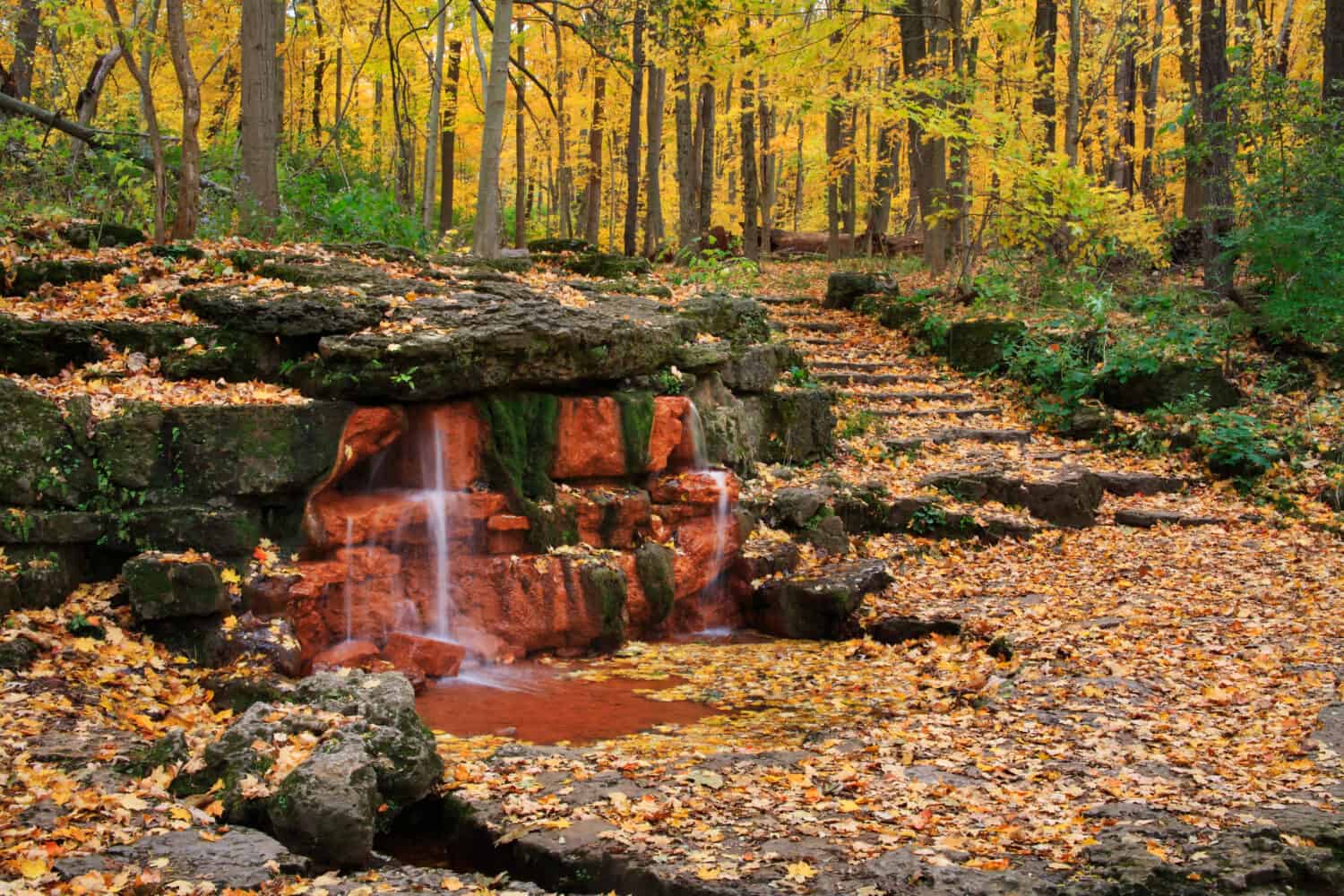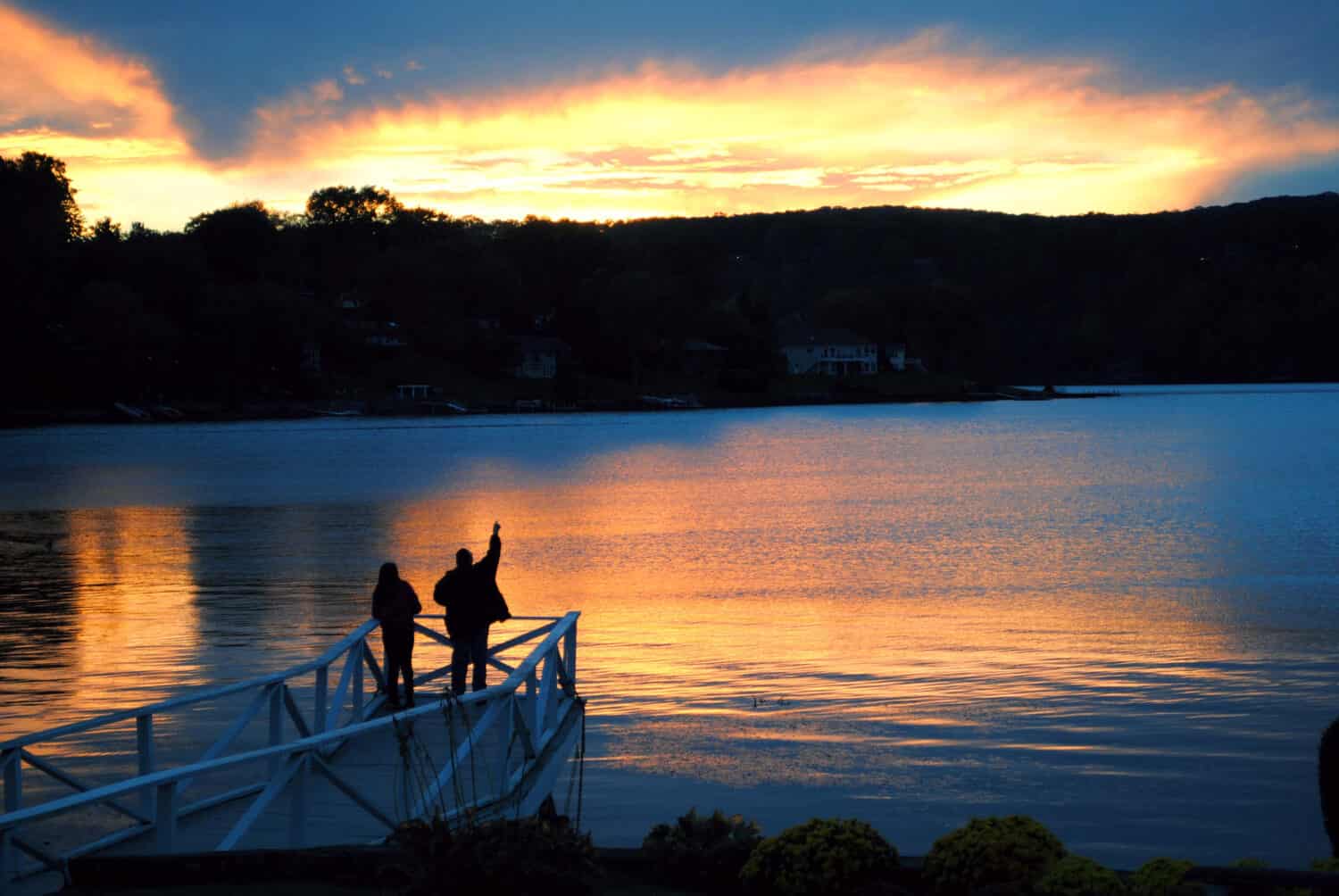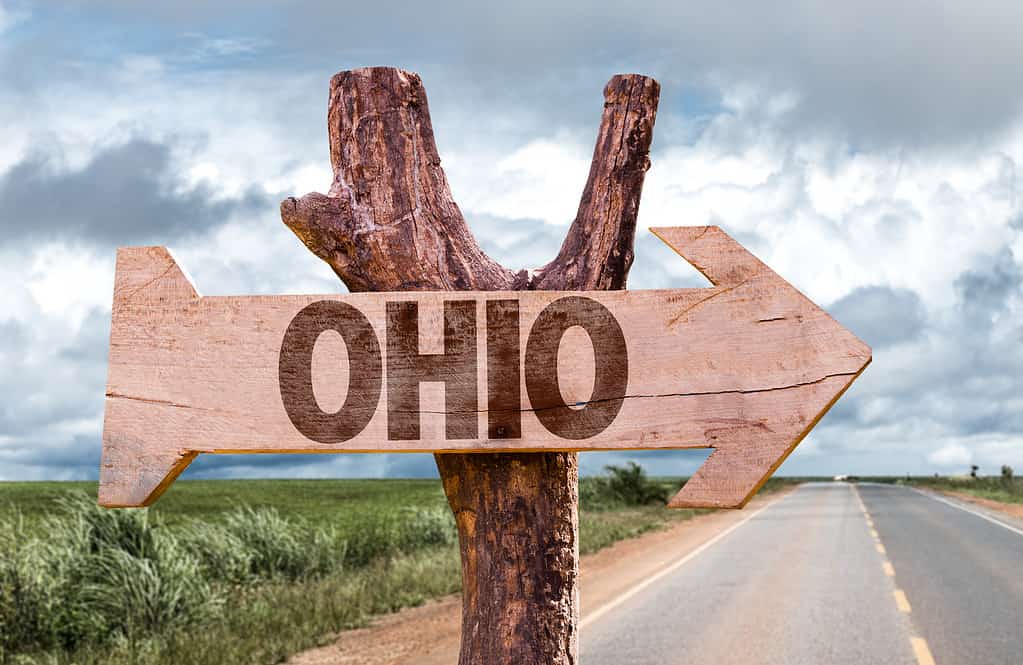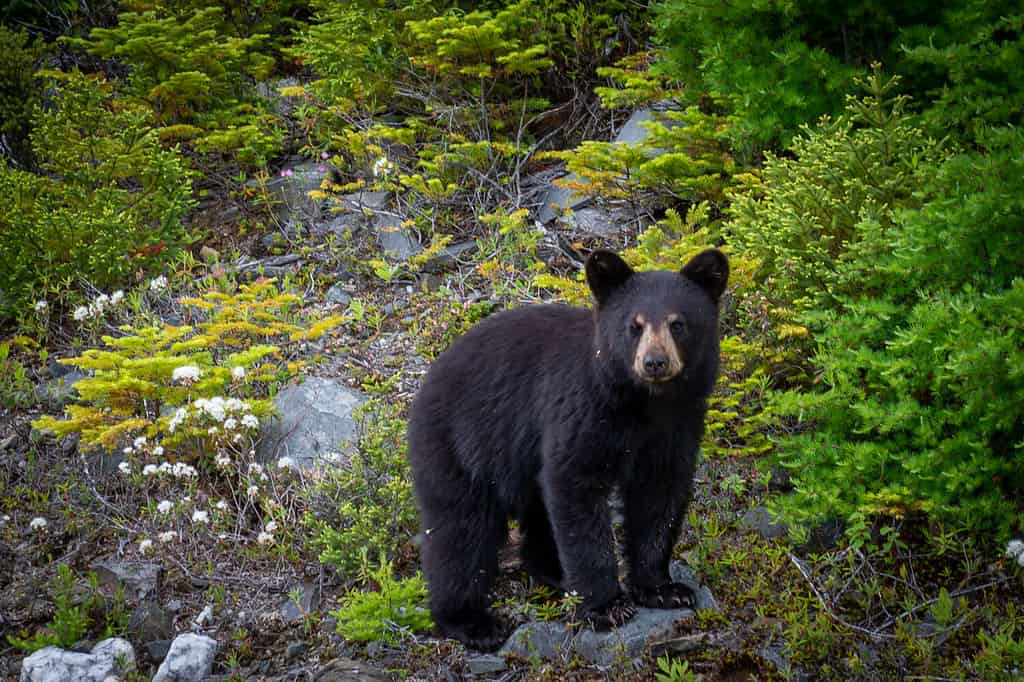In Ohio, you’ll find some famous bodies of water. Lake Erie is up north, and it’s one of North America’s five Great Lakes, ranking fourth in size. And let’s not forget the star of the show, the Ohio River, which might just be the secret behind the state’s name. One theory suggests “Ohio” could come from the Iroquois word “oyo,” meaning “the great river.”
For this article, we’ll be exploring some of the natural springs in Ohio, and where to find them. Some of these spots are perfect for planning an adventure. Fishing, camping, hiking, and even cliff diving; there’s a lot these springs have to offer.
Natural Springs in Ohio
- Yellow Springs, OH, got its name from a famous yellow spring that was said to have healing powers in the 1800s.
- Candlewood Lake in Morrow County, OH, is a 1,500-acre vacation community with its own 250-acre spring-fed lake.
- Mineral Springs in Adams County, OH, offers crystal-clear waters, hiking, camping, fishing, and water activities.
- Nelson Ledges Quarry Park Lake (NLQPL) is a stunning spring-fed lake near Ohio’s highest point.
- Blue Hole is a historic pond fed by an underground spring.
- Seven Creeks Roadside Spring is a spot where you can fill up containers with fresh spring water.
What Are Springs?
Springs come to life through a fascinating process. It all begins with the gentle touch of rainwater finding its way into an aquifer beneath the Earth’s surface. As the water infiltrates the aquifer it gradually amps up the pressure within. The pressure encourages movement, forcing the water to begin an underground journey through cracks and tunnels within the aquifer. Finally, water emerges at the surface, creating the natural phenomena we know as springs.
Why Some Springs Look Blue
Why do some springs look blue? The answer has to do with where color comes from in the first place. Things have colors because they take in some light and bounce off others. The color they bounce back is the shade we see.
In natural springs, the light waves bounce off of tiny water molecules, which like to take in red light and bounce off blue light. So, pure water often looks a bit blue because it reflects blue light.
Other factors also influence the spring’s color. If there are things like green minerals or muddy sediments in the water, it might look different colors.
1. Yellow Springs

Located within the Glen Helen Nature Preserve, Yellow Spring was initially discovered around 1800.
©Doug Lemke/Shutterstock.com
Yellow Springs, a village situated in the southwest region of Ohio, derives its name from a yellow spring that had a big reputation. Located within the Glen Helen Nature Preserve, this natural wonder was initially discovered around 1800. The Yellow Spring gained fame due to rumors of its healing properties. The spring was a major attraction for its era, attracting visitors from all over the place.
Little Miami Scenic Trail
The Little Miami Scenic Trail, stretching as the fourth longest paved trail in the United States, serves as a busy thoroughfare for outdoor enthusiasts. Visitors can regularly spot hikers, bicyclists, and even occasional horseback riders enjoying this scenic route. The village’s economic success took a leap with the completion of the Little Miami Railroad in 1846, establishing Yellow Springs as a vital trade and recreation hub in the region.
Explore Greene County
Yellow Springs is in Greene County Ohio. Greene County boasts several captivating natural areas, including John Bryan State Park, Clifton Gorge State Nature Preserve, and Glen Helen Nature Preserve. Here, you can explore over 2,000 acres of woodlands, rivers, and streams, experiencing the natural beauty and serenity that these areas offer.
2. Candlewood Lake

The lovely Candlewood Lake is a human-made lake that’s spring-fed.
©Christina Marinette/Shutterstock.com
Nestled within a 1,500-acre vacation-style community, you’ll find Candlewood Lake. This 250-acre spring-fed lake is in the peaceful landscape of Morrow County, just north of Mt. Gilead, OH. Along with a spring-fed lake, the community also sets aside about 140 acres for parks, green spaces, and various amenities. It’s the perfect spot to visit when you’re ready to take a break from the fast pace of city life.
Story of a Spring Fed Lake
The story of Candlewood Lake goes back to the early 1970s when a private developer first started this project. Fast forward more than four decades and this place has grown into a lively and close-knit community. It now boasts over 600 homes on 3,000 lots, attracting both full-time and part-time residents.
But the journey to create Candlewood was far from easy. The project was complex and ambitious, taking several years to complete. Developers faced financial challenges, including a time when they ran out of funds completely. Yet, despite these obstacles, the development managed to create essential amenities such as a lake, a recreational vehicle park, lodges, and pools.
3. Mineral Springs

Mineral Springs clear waters are home to freshwater
jellyfish
.
©Rostislav Stefanek/Shutterstock.com
Come and explore the natural wonder that is Mineral Springs! This beautiful, spring-fed lake in Adams County, OH, is nature’s aquarium. The water is so clear you can spot all sorts of marine species swimming around. Along with fish, you might even spy a freshwater jellyfish.
Around the spring you’ll find hiking trails, camping spots, and all sorts of other fun adventures. Whether you’re into fishing, water activities, or just soaking up the serenity of nature, there’s something for everyone. Looking to plan a vacation? For the ultimate experience, consider staying at Mineral Springs Lake Resort in Peebles, OH. If tent camping isn’t your style, they have cabin rentals to make your stay a bit more comfy.
4. Nelson Ledges Quarry Park Lake

There are hundreds of camping spots at Nelson Ledges Quarry Park.
©New Africa/Shutterstock.com
Nelson Ledges Quarry Park Lake, also known as NLQPL, is a beautiful spring-fed. It’s one of the natural springs in Ohio known for its crystal-clear waters. It’s nestled near one of the highest points in Ohio, where water flows in two different directions, towards the Ohio River and Lake Erie.
Located in Garrettsville, Portage County, OH, this is one of the cleanest lakes in Ohio. The lake’s average depth is around 30 feet, and on a sunny day, you can see down to 15 feet or even more. Scuba diving here is one of the best freshwater experiences in the Tri-State area.
Surrounding NLQPL, you’ll find a stunning forest. The park covers 250 acres and offers a range of activities, including camping, fishing, and rock climbing. You’ll find roughly 750 basic campsites and 60 RV sites, some with electricity. NLQPL also hosts fun festivals and events throughout the year, like Summerdance and the Sunny Days Festival.
Ice Age Sculptures
For the adventurous, there’s cliff jumping from rock ledges around the lake. The incredible rock formations at Nelson Ledges are the result of natural forces during the Ice Age. These rock formations are among the few exposed outcrops in northern Ohio, as most similar formations in the region have been covered by soil and debris left by retreating glaciers.
The area around the rock formations is rich in biodiversity, with various wildflowers, trees, and ferns thriving among the jumbled rocks and shaded rock faces. The spring wildflower display includes species like spring beauties, hepatica, and trillium, with the rare red trillium on the ledges.
Historical Trade
Centuries ago, the area around Nelson Ledges was important to various Native American tribes, including the Delaware, Shawnee, Miami, Seneca, Mohawk, and Cayuga. The Delaware tribe was especially active, using this area for trade and travel. Later on, the area became a popular spot for agriculture and dairy, with cheese-making becoming a major industry by the 1830s.
5. Blue Hole

Blue Hole is situated right by the Little Miami River in Clifton Gorge State Nature Preserve.
©Doug Lemke/Shutterstock.com
Have you heard about the mysterious Blue Hole in Ohio? The pond is the result of an underground spring that flows right into Lake Erie. This special place is situated right by the Little Miami River in Clifton Gorge State Nature Preserve. The pond’s enchanting blue color is due to a mix of factors like water chemistry, pool depth, and the lack of organic debris.
The Blue Hole itself is over 10,000 years old! It came to be about 12,000 to 15,000 years ago during the last ice age when glaciers melted and shaped the land. There were local legends that said the pond might be bottomless, but that’s a bit of a stretch. It’s actually about 45 feet deep.
Why Blue Hole Closed
The spring was a famous attraction from the 1920s until the early 1990s when it closed to the public. Why did they close the popular Blue Hole? It turns out a few reasons were contributing to the decision. One of those reasons was finances.
Expensive upgrades were necessary to meet the requirements of the Americans with Disabilities Act. And it was hard to justify paying for the upgrades when business was struggling. New water attractions in the area began drawing people away, forcing the Blue Hole to shut down.
As for ownership, the Blue Hole now belongs to the Castalia Trout Club, which has owned it since it started back in 1890. They use the cold waters of the pond for their fish hatchery.
While there are other blue holes in the area, none are quite as famous as the original. But here’s some good news: you might still get a chance to see the mesmerizing blue waters of the original Blue Hole. The Castalia Historical Society holds a raffle, and if you win, you’ll get the opportunity to visit this historic site.
6. Seven Creeks Roadside Spring

Take a road trip to check out the Seven Creeks Roadside Spring where you can get fresh spring water.
©Prostock-studio/Shutterstock.com
Have you heard about Seven Creeks Roadside Spring? It’s one of the natural springs in Ohio where you can fill a jug with organic spring water! You can find this refreshing spring on Seven Creeks Road in Island Creek Township, OH.
If you’re hiking, consider bringing a wheelbarrow to make transporting the water easier. When it comes to storing your fresh spring water, opt for glass containers, this will help maintain the water’s purity. Even BPA-free plastics can contain chemicals that may leach into the water and raise health concerns.
The great thing about this spring is its commitment to providing completely natural, chemical-free spring water without removing any minerals. This location takes water quality seriously and conducts annual lab testing to ensure the water is top-notch.
After filling your glass water containers with refreshing spring water, explore the area. There are a lot of great destinations to check out. You can head over to the Jefferson County Historical Museum & Library for a dose of local history.
Spring Water Helps Make Insanely Good Coffee
People often say that fresh spring water is the ideal choice for making a truly exceptional cup of coffee. Beyond its great taste, spring water can be beneficial for your health. Unprocessed spring water from a safe source retains essential minerals like calcium and magnesium. On the other hand, many store-bought bottled spring waters undergo pasteurization for shelf stability. This can diminish some of its health benefits, like increased hydrogen levels and healthy probiotics.
Giving Back
Consider giving back to the environment before collecting water from the spring. Springs are sacred spots for many cultures. They provide life-giving water and symbolize a connection to the inner earth. Giving back can be something as simple as picking up any trash in the area or clearing debris.
Wildlife in and Around the Natural Springs in Ohio

Ohio is home to 67 mammal species, 39 amphibian species, 45 snake species, and 219 bird species.
©gustavofrazao/iStock via Getty Images
What animals live in and around Ohio’s natural springs? Natural springs, forests, prairies, and wetlands, provide a rich habitat for a wide variety of wildlife in Ohio. The state is home to 67 mammal species, 39 amphibian species, 45 snake species, and 219 bird species. Some species are a bit more famous than others. Notable state symbols include the white-tailed deer (state mammal since 1988) and the cardinal (state bird since 1933).
What’s Flying Around the Natural Springs in Ohio?

Canada geese are a common sight swimming around Ohio’s springs.
©Krasula/Shutterstock.com
While visiting the natural springs in Ohio, don’t forget to look up! This state is home to all sorts of big and small water birds.
Here are some of the species birding enthusiasts might see:
- Eurasian Teal
- Great Egret
- Great Blue Heron
- Mallards
- Mute Swan
- Wood Ducks
- American Coots
- Canada Geese
- Green Herons
- Common Loons
- Double-crested Cormorants
- Pied-billed Grebes
- Snowy Egrets
- Cattle Egrets
- Northern Pintails
- Buffleheads
Mute Swan
Have you ever seen a mute swan in the wild? With their long necks and lovely white plumage, mute swans symbolize peace and grace. However, they compete with native species in Ohio’s wetlands, making them a topic of conservation concern.
Canadian Geese
Sharing the water with the swans, you’ll find plenty of geese. They’re a common sight in Ohio. Recognizable by their large size and distinctive markings, Canadian geese can become pretty bossy during the breeding season.
Ducks
Ohio is also home to ducks. Lots and lots of ducks. Take for instance the famous mallard. These medium-sized ducks are quite common in Ohio and are known for their distinct male and female coloration. You’ll often find them in shallow marshes and along our rivers, adding a splash of color to our landscapes. Along with mallards, keep your eyes peeled for the lovely wood ducks. These striking ducks, particularly the males with their vibrant plumage, prefer wooded swamps and riparian areas.
Eurasian Teal
Ohio is home to a fascinating array of water birds, like the Eurasian teal. While not native to Ohio, it’s a captivating sight when spotted in our wetlands. This small duck, adorned with vibrant green wing highlights, typically calls Europe and Asia home.
Great Egret
Then there’s the impressive tall species, like the great egret. As one of the larger wading birds, the great egret can be found on multiple continents. It’s a skilled aquatic predator, often seen patiently hunting for aquatic prey in Ohio’s waterways.
Great Blue Heron and Green Heron
Ohio is proud to house the great blue heron, another tall water bird. Native to the Americas, the great blue heron is comfortable in a variety of settings. It can be found in various habitats in Ohio. And along with the great blue heron, there’s also a green heron to look out for. These small, stocky birds are great foragers in various wetland habitats. Watch their patient stalking as they search for their next meal.
What Fish Are in the Springs and Streams?

Largemouth bass in Ohio are typically 12-15 inches long and weigh 1-3 pounds.
©Pierre Rebollar/Shutterstock.com
Ohio’s abundant waterways include over 40,000 miles of streams, which are home to over 160 fish species. Some species are more common than others, such as the longnose gar, striped shiner, golden redhorse, warmouth, southern redbelly dace, black redhorse, northern hog sucker, greenside darter, johnny darter, logperch darter, and rainbow darter.
Managing this aquatic bounty is the responsibility of the ODNR Division of Wildlife. They oversee inland water areas, stream networks, and a big portion of Lake Erie. It’s a big job, and it takes a lot of people to get it done right. The ODNR’s efforts include enhancing spawning habitats, implementing fishing regulations, and more.
Fishing Tips
Fishing holds a special place in Ohio’s heritage, passed down through generations. Experienced anglers learn tips and tricks that have been catching fish for decades. For instance, did you know that largemouth bass love both natural and artificial baits? On the other side of the scale, we have smallmouth bass, also called brown bass or smallies. Fly fishing, baitcasting, spin casting, and live bait methods help snag this catch.
Black Bears: Ohio’s Endangered Species

In Ohio, black bears are considered an endangered species.
©Dolores M. Harvey/Shutterstock.com
Ohio keeps a close watch on black bears, which are a state-endangered species and also the most common bear species in North America. In the past, Ohio had a thriving black bear population, but deforestation led to their decline. By the mid-1850s, black bears were thought to be extinct in Ohio, although occasional sightings still occurred.
In a positive turn of events, a sow with cubs was reported in 1973, suggesting the possible return of black bears to Ohio. Since 1993, black bear sightings have been on the rise, with 191 reported in 2018 across 45 counties. These sightings are most common from late May through early July.
Interestingly, most bears seen in Ohio are young male bears moving in from neighboring states. And they’re not always a true black. Sometimes black bears are a mix of colors ranging from chocolate brown, cinnamon brown, blue-black, and white. Some bears are smaller weighing in around 150, while others reach an impressive 700 pounds. On average, males weigh around 300 pounds, while females tend to be around 175 pounds.
Final Thoughts on Natural Springs in Ohio
Ohio’s natural springs are more than just water sources; they’re a part of the state’s history. Yellow Springs is famous for its healing waters, and the peaceful Candlewood Lake is human-made and fed by a spring. Nelson Ledges Quarry Park Lake is also a spring-fed lake, and the Blue Hole is a 10,000-year-old wonder. Finally, Seven Creeks Roadside Spring provides fresh water, as does the fun and popular Mineral Springs.
While not all of the springs are open to the public, like the Blue Hole, they are always available to Ohio’s wildlife. Large aquatic birds like great blue herons, swans, and geese, are frequent flyers. As are all sorts of fish, snakes, frogs, deer, coyotes, and more.
The photo featured at the top of this post is © Doug Lemke/Shutterstock.com
Thank you for reading! Have some feedback for us? Contact the AZ Animals editorial team.






